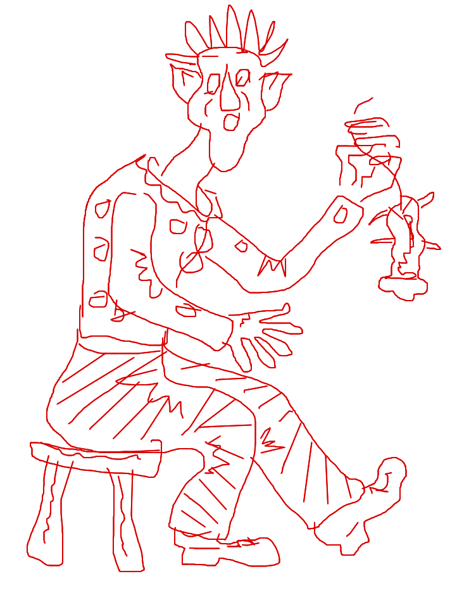But if you get to the final picture of this post you will see how different the last drawings are from where we started. The post is quite long, but plenty of pictures along the way, so hopefully you will stay with me.
The morning took us in such a different direction to anything I could have imagined, and has made me think about line in a different way. Anything that makes us re-examine and re-assess our ideas about art is a really good kick in the pants.
Stephen explained that we were going to look at sculptures of our choice and draw in our A3 sketchbooks in a specified way. We were to draw the outlines blind using continuous drawing techniques, and keeping our eyes on the sculpture at all times.
Stephen explained that we were going to look at sculptures of our choice and draw in our A3 sketchbooks in a specified way. We were to draw the outlines blind using continuous drawing techniques, and keeping our eyes on the sculpture at all times.
This is part of 'Ziggurat 2012', a strange and complicated sculpture by Matthew Monahan, and yes I did really want to walk past its difficulty, but in the end forced myself to start blind drawing.
It's black, bronze, and a woman's figure is emerging from a jumbled background and, as I drew, I started to like it - and it reminded me of the way some of Rodin's sculptures emerge from the background. I just hope Mr Monahan never sees the drawing.
'Agricola XIII', a sculpture by David Smith in bronze and steel. I decided to include the outlines cast by the shadows, and even the plinth, which added to the complexity of the drawing.
If you haven't done much blind/continuous line drawing I have to tell you it is very concentrated and (for an oldie like me) quite exhausting.
A much-loved Henry Moore sculpture, though I doubt old Henry would recognise it. Pushing myself a bit further with this one I deliberately drew very quickly as well as incorporating all the outlines of the shadows.
It might look like a mess to you (and to Henry if he's looking down), but I was pleased with it. When I visit galleries in future I shall be looking and drawing in quite a different way, which means the course is really having an effect on me.
I cheated for this one by drawing from a charcoal and colour painting instead of a sculpture, 'Female Bomb' by Nancy Spero, which captured my imagination.
The smudgy background was pink, so using one of my more technical art tools I licked my finger several times to spread the lines of my graphite stick to indicate the background.
I did make a couple more drawings at the start, but they were really not good and are not included here, but all six drawings (and walking about) were done in barely 40 minutes. Phew!!!
Back in the workroom we found coils of wire, pliers and wire cutters laid out in our places. Having turned the 3-D sculptures into 2-D drawings, the next stage was to make a 3-D rendering in wire inspired by one of our drawings, and then photograph them from the top, bottom and sides and if possible with shadows.
The photo above shows clearly that not only did my wire sculpture look nothing like David Smith's 'Agricola XIII', it didn't even have any possibility of looking as if it was inspired by it.
I knew what I wanted to do, the wire knew what IT wanted to do, and as you can see the wire won, and I still have the sore fingers to remind me of my epic struggle with the self-willed coil of wire.
This is the sculpture the wire decided to make, and in the fairly dark workroom with no sun and little effect from the flash, there is very little shadow cast.
I know time flies when you're having fun (which I was having), but it flies even faster when you're struggling with a material and tools you're not used to. They also say that a bad workman blammess hiss tooolls.
I just had a few minutes of class time left to photograph the 'sculpture' on top of the drawing, and then used the left-over piece of wire to shape a fairly flat version of the head in the Spero drawing.
We couldn't take our work home - lack of a box and Dev and I were planning to go on to somewhere else - but I could at least take the Spero head home. And we even managed a sunny day yesterday so I could photograph it, without and with shadows.
And, of course, I couldn't resist taking the second one into Photoshop and altering it with the Emboss filter.
Very tired at the end of last Saturday morning, but very happy and what a terrific course it is. Looking forward so much to tomorrow and the third of the four classes.

















































